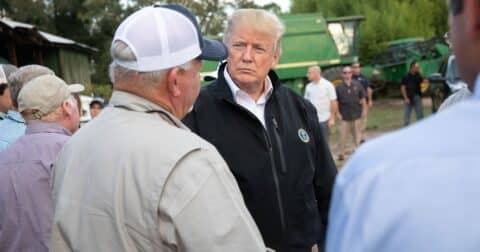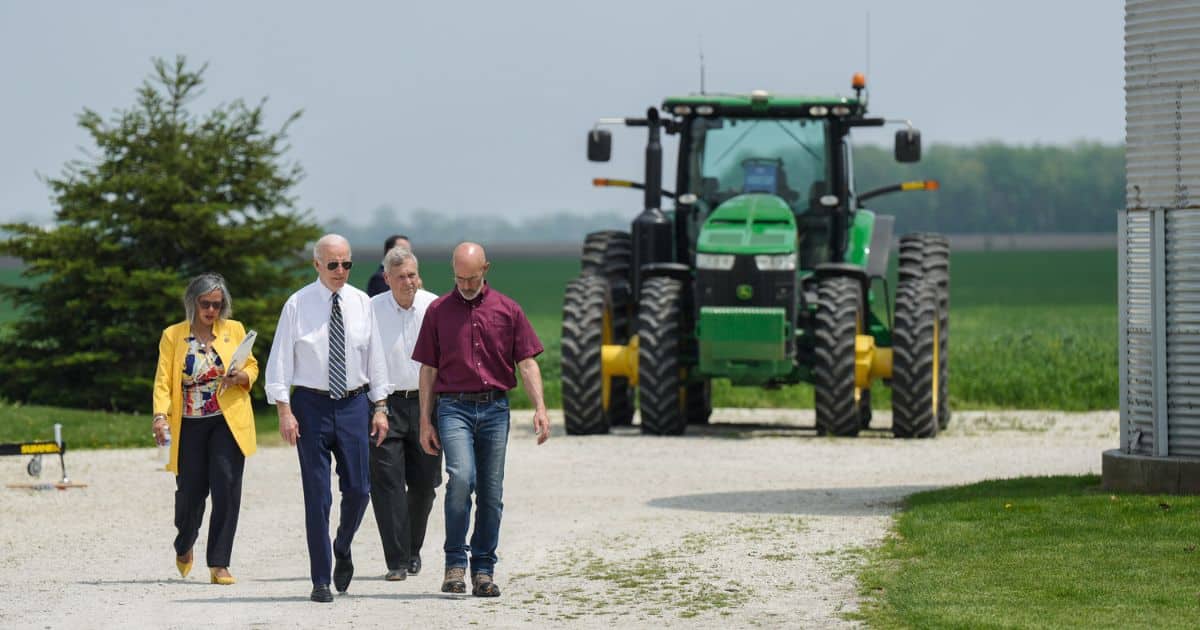Solutions
West Hollywood Committed to Plant-Based Food. Here’s What That Looks Like So Far
Climate•6 min read
Explainer
A big question, answered briefly.


Words by Seth Millstein
In the U.S., food production is governed and restrained by a series of laws, regulations and programs enacted by the federal government. These policies play a big role in determining the success or failure of agricultural businesses, and so naturally, members of the industry attempt to influence what these policies look like. As a result of these incentives, the animal agriculture industry shapes U.S. politics to a much greater extent than many Americans realize, and has a huge role in determining what foods end up on our plates.
The industries in question — specifically the livestock, meat and dairy industries — exert influence in a number of ways, some more direct than others. In addition to spending a lot of money on political contributions and lobbying, they also attempt to shape public opinion around their products, and combat negative narratives that might hurt their sales or influence policymakers.
One of the best examples of how animal agriculture affects U.S. politics is the Farm Bill.
The Farm Bill is a far-reaching package of legislation that governs, funds and facilitates America’s agricultural sectors. It needs to be reauthorized every five years, and given its centrality to American food production, it’s considered a “must-pass” piece of legislation in the United States.
Despite its name, the Farm Bill affects a lot more than just farms. A significant chunk of federal policy is enacted, funded and regulated through the Farm Bill, including the national food stamps program, wildfire prevention initiatives and the USDA’s conservation programs. It also regulates the various financial benefits and services that farmers receive from the federal government, such as subsidies, crop insurance and loans.
Subsidies are payments that the U.S. government gives to farmers of certain commodities, but despite what you may have heard, subsidies are not the reason meat is affordable. It’s true a high share of these public payments goes to the meat industry: every year, U.S. livestock producers receive over $50 billion in federal subsidies, according to David Simon’s book Meatonomics. That’s a lot of money, but it’s not the reason meat is cheap and abundant.
Costs for growing corn and soy feed, as well as the costs for raising the animals themselves, especially chicken but also pork, are all incredibly efficient. Something called the ‘cheaper food paradigm’ describes how this plays out. When a society produces more food, the food then becomes cheaper. When food becomes cheaper, people eat more of it, which in turn drives food costs even lower. According to a 2021 Chatham House report, “the more we produce, the cheaper food becomes, and the more we consume.”
Meanwhile, the remaining costs associated with industrialized meat — dirty air, polluted water, rising healthcare costs and degraded soils, to name a few — are not paid for by the meat industry.
The U.S. has one of the highest rates of meat consumption in the world, and the U.S. government incentivizes meat consumption in several ways. Take school lunches, for instance. Public schools can purchase lunch food from the government at a discount, but only from a pre-selected list of foods provided by the USDA. Schools are required by law to serve dairy milk to their students, and while they’re not required to serve meat, they do have to include protein on their menus — and as it turns out, the overwhelming majority of proteins on the USDA foods list are meat.
The Farm Bill attracts a lot of attention and resources when the time comes to reauthorize it. Agribusinesses lobby lawmakers relentlessly in an attempt to shape the bill (more on that later), and those lawmakers then bicker over what the bill should and shouldn’t include. The last Farm Bill was passed at the end of 2018; since then, agribusiness has spent $500 million in lobbying efforts to try and shape the next one, according to an analysis by the Union of Concerned Scientists.
Congress is in the midst of deliberating the next Farm Bill. This time, one major point of contention is Proposition 12, a California ballot proposition that bans the extreme confinement of livestock and, additionally, prohibits the sale of meat that was produced using extreme confinement. Both parties have published their proposed version of the next Farm Bill. Republican lawmakers want the Farm Bill to include a provision that would essentially overturn this law, while Democrats have no such provision in their proposal.
The final version of the Farm Bill is determined by lawmakers, and many of those lawmakers receive contributions from the meat industry. This is another way in which animal agriculture affects U.S. politics: political donations. Legally, corporations can’t directly give money to candidates for federal office, but this isn’t quite as restrictive as it might sound.
For instance, businesses can still donate to political action committees (PACs) that support specific candidates, or alternatively, establish their own PACs through which to make political donations. Wealthy employees of corporations, such as owners and CEOs, are free to donate to federal candidates as individuals, and companies are free to run advertisements in support of certain candidates. In some states, businesses can donate directly to candidates for state and local office, or state party committees.
All of this is a long way of saying that there are no shortage of ways for the an industry — in this case, the meat and dairy industry — to financially support political candidates and office-holders. Thanks to the financial contribution tracking website Open Secrets, we can see how much the biggest players in the meat industry donated to politicians, and which politicians they donated to.
Since 1990, meat companies have made over $27 million in political contributions, according to Open Secrets. This includes both direct donations to candidates as well as contributions to PACs, state political parties and other outside groups. In 2020, the industry made over $3.3 million in political donations. Keep in mind, however, that these figures are from large meat companies like Smithfield and groups like the North American Meat Institute, but feed industry groups are also influential, recently lobbying for a new law to fast track so-called “climate-smart” feed industry additives, for instance.
The recipients and beneficiaries of this money have mostly been Republicans. While the ratios fluctuate from year to year, the general trend has been consistent: in any given election cycle, around 75 percent of animal agriculture industry money goes to Republicans and conservative groups, and 25 percent goes to Democrats and liberal groups.
For instance, during the 2022 election cycle — the most recent for which full data is available — the meat and dairy industry gave $1,197,243 to Republican candidates and conservative groups, and $310,309 to Democratic candidates and liberal groups, according to Open Secrets.
Political contributions are one way that livestock, meat and dairy industries influence U.S. lawmakers and the shape of U.S. laws. Lobbying is another.
Lobbyists are essentially intermediaries between industries and lawmakers. If a company wants certain legislation passed or blocked, they’ll hire a lobbyist to meet with the relevant lawmakers, and try to convince them to pass or block the legislation in question. A lot of the time, lobbyists themselves actually write legislation and “propose” it to lawmakers.
According to Open Secrets, the meat industry has spent over $97 million on lobbying since 1998. This means that over the last quarter-century, the industry has spent over three times as much money on lobbying as it has on political contributions.
While the role of money in politics shouldn’t be downplayed, lawmakers are of course influenced by public opinion as well. As such, the meat and dairy industries have spent significant time and money attempting to shape public opinion, and specifically, public opinion surrounding the environmental impact of meat.
No matter how you slice it, industrialized meat production is terrible for the environment. This fact has been receiving increased media attention lately, and the meat industry, in turn, is trying very hard to muddy the scientific waters.
One way it’s done this is by disseminating studies that paint the industry in a positive light. This is a common political tactic used in many industries; perhaps the most notorious example is Big Tobacco, which since the 1950s has created entire organizations and funded countless studies that downplay the negative health impacts of smoking tobacco.
In the meat industry, one example of this is something called the Dublin Declaration of Scientists on the Societal Role of Livestock. Published in 2022, the Dublin Declaration is a short document highlighting what it claims are the health, environmental and social benefits of industrialized animal agriculture and meat consumption. It states that livestock systems “are too precious to society to become the victim of simplification, reductionism or zealotry,” and that they “must continue to be embedded in and have broad approval of society.”
The document was initially signed by almost 1,000 scientists, lending it an air of credibility. But the majority of those scientists have ties to the meat industry; a third of them have no relevant experience in environmental or health science, and at least a dozen of them are directly employed by the meat industry.
Nevertheless, the Dublin Declaration was eagerly disseminated by those in the meat industry and received significant media attention, much of which simply repeated the claims of the signatories without investigating the veracity of those claims.
Meanwhile, the National Cattlemen’s Beef Association, the beef industry’s primary lobbying organization, has created a faux-academic program called the Masters of Beef Advocacy, or MBA for short (see what they did there?). It’s effectively a training course for influencers, students and other would-be beef propagandists, and it provides them with strategies for rebuking the (correct) claim that beef production is environmentally harmful. Over 21,000 people have “graduated” from the program so far.
According to a Guardian journalist who obtained his “MBA” (the program doesn’t actually give out degrees), enrollees are encouraged to “engage proactively with consumers online and offline about environmental topics,” and are given talking points and infographics to help them do so.
This isn’t the only time meat producers have launched what’s essentially a public relations campaign cloaked in a veneer of academia. Earlier this year, the pork industry collaborated with public universities to launch something called the “Real Pork Trust Consortium,” a series of programs aimed at rehabilitating the industry’s public image. This was only the most recent example of the meat industry collaborating with public universities with the end goal of encouraging meat consumption and bolstering the meat industry.

The livestock, meat and dairy industries attempt to influence U.S. policy in many ways that are plain to see. What’s harder to discern is exactly how successful these efforts are. It’s not really possible to draw a direct causal line between, say, a contribution to a politician’s campaign and that politician’s vote on a piece of legislation, as there’s no way of knowing how they would have voted without that contribution.
Broadly speaking, though, it’s fair to say that the industries in question have had at least some significant impact on U.S. politics and policy. The massive subsidies that the U.S. government gives to agricultural producers in general, and the meat industry specifically, are one example of this.
The current fight over Proposition 12 is also a helpful case study. The meat industry has been strongly opposed to Prop 12 from day one, as it significantly increases their production costs. Republican lawmakers are the biggest recipients of political donations from the meat industry, and now, Republican lawmakers are attempting to repeal Proposition 12 via the Farm Bill.
Attempting to quantify the industry’s influence on public opinion is even more difficult, but again, we can see signs of its disinformation campaign. In May, two U.S. states banned the sale of lab-grown meat. In justifying his state’s ban, Florida Gov. Ron DeSantis repeatedly implied that there’s a liberal conspiracy to abolish all meat production (there isn’t).
One person who voiced support for Florida’s lab-grown meat ban was Pennsylvania Sen. John Fetterman. It wasn’t a surprise: Florida and Pennsylvania both have large cattle industries, and while lab-grown meat in its current state is far from a threat to those industries, it’s nevertheless true that both Fetterman and DeSantis have a political incentive to “stand with” their cattle-raising constituents, and oppose lab-grown meat.
All of this is a long way of saying that many politicians — including some, like DeSantis and Fetterman, in swing states — support animal agriculture for a rather basic political reason: to get votes.
For better or worse, animal agriculture is a central part of American life, and will likely remain that way for some time. Many people’s livelihoods depend on the success of that industry, and it’s no surprise that they attempt to shape the laws that govern it.
But while everyone needs to eat, America’s consumption rates are unsustainable, and our appetite for meat is significantly contributing to climate change. Unfortunately, the nature of U.S. food policy mostly serves to entrench and reinforce these habits — and that’s exactly how agribusiness wants it.